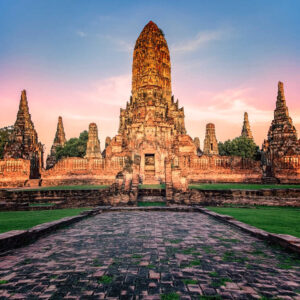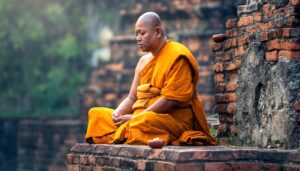Religion
Theravada Buddhism is Cambodia’s state religion and has been since the 13th century, except during the Khmer Rouge period. During that time, all monks were disrobed or killed and most religious scholars were murdered or fled into exile. Today the country is about 95 percent Buddhist. There are also two Muslim communities, the Cham and the Malay, making up 3 percent of the population. Just under 3 percent are Christians, plus there is a substantial population of Western missionaries trying to raise that figure. In the northeast of the country, many of the ethnic minority groups practice tribal religions.
 Before Cambodia embraced Buddhism, there was Hinduism. Back in the day, Hinduism was one of the Khmer Empire’s official religions. In fact, Angkor Wat is the largest Hindu temple in the world, and one of the only dedicated to Brahma. And while Hinduism is no longer directly practiced in Cambodia, it influences Khmer Buddhist practices, such as weddings, funerals, and the use of astrology to find auspicious dates for important events. The Cambodian approach to Buddhism is the same as their approach to most things: relaxed. Most Cambodians visit the pagodas for the major Buddhist holidays, such as Pchum Ben (Ancestor’s Day), and this is often the extent of their religious observances. Few Cambodians abstain from all of the Five Precepts of Buddhist belief, which prohibit killing, stealing, fornication, lying, and drinking. While they may not follow all of the rules, Cambodians still believe in reincarnation and the idea that one’s position in life is derived from past actions. (This may explain why, as a rule, they treat their dogs so poorly.)
Before Cambodia embraced Buddhism, there was Hinduism. Back in the day, Hinduism was one of the Khmer Empire’s official religions. In fact, Angkor Wat is the largest Hindu temple in the world, and one of the only dedicated to Brahma. And while Hinduism is no longer directly practiced in Cambodia, it influences Khmer Buddhist practices, such as weddings, funerals, and the use of astrology to find auspicious dates for important events. The Cambodian approach to Buddhism is the same as their approach to most things: relaxed. Most Cambodians visit the pagodas for the major Buddhist holidays, such as Pchum Ben (Ancestor’s Day), and this is often the extent of their religious observances. Few Cambodians abstain from all of the Five Precepts of Buddhist belief, which prohibit killing, stealing, fornication, lying, and drinking. While they may not follow all of the rules, Cambodians still believe in reincarnation and the idea that one’s position in life is derived from past actions. (This may explain why, as a rule, they treat their dogs so poorly.)
Most Cambodians identify as Buddhist, but their version of Buddhism includes forms of ancestor worship, shamanism, and animism that predate Buddhism. In almost all Cambodian homes (and even at the temples), you’ll find spirit houses, small shrines to appease bad spirits and keep them away from the homes’ residents. Most Cambodians, particularly in the provinces, believe in ghosts and spirits. There are myriad folk tales about sorcery and ghosts that many Khmers accept as fact. One such is the story of a half-ghost, half-girl who slips through the windows of houses after pulling out her internal organs and leaving her corpse outside. Khmers call this spirit arb, or arb thmob. Shamans are often consulted for illnesses which are believed to have been caused by evil spirits.
 Unlike in most Christian religions, Buddhists who take vows to become a monk do not commit to this calling for life. It is common for Cambodian men to become monks for a short period of their life — usually a few weeks or a few months — to bring merit to their parents and to become closer to their Buddhist faith. This is usually done earlier in life, starting at age 13. The most common reason, though, that low-income Cambodians choose to become monks is to gain access to education that they might not be able to get otherwise. And for poor families in the provinces, having one less mouth to feed is a tempting proposition (long-term monkhood is much more common among Khmer youth from the countryside). Today less than 5 percent of men become monks, compared to 50 percent in the pre-Khmer Rouge days and close to 100 percent a century ago.
Unlike in most Christian religions, Buddhists who take vows to become a monk do not commit to this calling for life. It is common for Cambodian men to become monks for a short period of their life — usually a few weeks or a few months — to bring merit to their parents and to become closer to their Buddhist faith. This is usually done earlier in life, starting at age 13. The most common reason, though, that low-income Cambodians choose to become monks is to gain access to education that they might not be able to get otherwise. And for poor families in the provinces, having one less mouth to feed is a tempting proposition (long-term monkhood is much more common among Khmer youth from the countryside). Today less than 5 percent of men become monks, compared to 50 percent in the pre-Khmer Rouge days and close to 100 percent a century ago.
Older women, particularly widows, often choose to live at the pagodas as helpers so as not to be a burden on their families. Called mae chi, they shave their heads and eyebrows, clean and prepare the altars for ceremonies, and follow ten precepts (compared to the 235 that nuns used to keep).
There are also many Western religions and churches represented in Cambodia. See our Religious organizations and worship section for more details.
Sapa Sunshine Travel
We bring an interesting and safe trip to customers, tourist services play an important role in the journey. We ensure that we will provide you with a high quality service to make your trip more and more comfortable and memorable.
Custom Links
*Home
*Sapa Tours
*All Tours
*Services
*Where To Travel
*Travel Services
Contact Us
- Sapa Town, Lao Cai, Vietnam
- +84968812644
- info@sapasunshinetravel.com
- www.sapasunshinetravel.com
- www.sapasunshinetravel.com.vn
Copyrights 2021 – All rights reserved
- ←
-
Email Us
Please send us an Email
